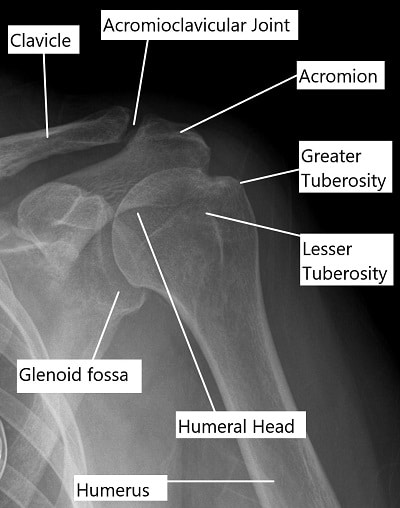AC Joint Pain
The acromioclavicular (AC) joint is a small but crucial joint in the shoulder where the collarbone (clavicle) meets the acromion of the scapula (shoulder blade). This joint plays an important role in shoulder movement and stabilization, enabling the arm to move freely across a wide range of motions. Injuries to the AC joint, such as separation or arthritis, can cause pain, restricted movement, and functional impairments. These injuries often affect athletes and individuals who perform repetitive overhead movements. Treatment options range from non-operative methods to surgical intervention, depending on the severity of the injury.

X-ray of the shoulder joint.
Functional Anatomy
The AC joint allows for gliding motions and plays a pivotal role in the overhead movement of the arm. It consists of two primary bones: the clavicle and the acromion of the scapula. The joint is stabilized by ligaments, including the acromioclavicular ligament (providing horizontal stability) and the coracoclavicular ligaments (trapezoid and conoid) that provide vertical stability. The clavicle itself rotates 40-50° posteriorly during shoulder elevation, while the AC joint contributes around 8° of rotation.
Biomechanics or Physiology
The AC joint is mainly responsible for facilitating the upward and downward motion of the arm. During shoulder movements, the clavicle rotates and glides to enable the scapula to move in sync. This joint’s stability is primarily dependent on the acromioclavicular ligament for horizontal motion and the coracoclavicular ligaments for vertical stability. Together, these ligaments prevent excessive movement of the clavicle, maintaining the integrity and function of the shoulder.
Common Variants and Anomalies
While the AC joint is typically stable in healthy individuals, various factors such as trauma, overuse, or degenerative conditions can lead to dysfunction. Some of the most common issues include:
-
AC joint separation, typically caused by trauma or contact sports, such as football or soccer.
-
Osteoarthritis (OA) of the AC joint, a result of cartilage degradation, leading to pain, swelling, and restricted movement.
-
Fractures of the clavicle or acromion, often resulting from direct trauma or falls.
-
Osteochondromas or benign bone tumors may also develop in the area, causing mechanical obstructions that result in pain and restricted motion.
Clinical Relevance
Injuries to the AC joint can significantly affect daily activities and athletic performance. The pain is typically localized at the top of the shoulder, particularly during movements that involve reaching overhead or across the body. Overhead athletes—such as tennis players, weightlifters, and swimmers—are particularly vulnerable to AC joint injuries. Diagnosing and treating these injuries early is crucial to prevent long-term complications like arthritis, instability, and chronic pain.
Imaging Overview
-
X-rays are commonly used to evaluate bone injuries, including fractures or separations of the clavicle or acromion.
-
CT scans provide a more detailed view, especially for bone malformations or fractures.
-
MRI and ultrasound are used to assess soft tissue injuries, including ligament damage and inflammation of the bursa (scapulothoracic bursitis).
Associated Conditions
AC joint issues often occur alongside other shoulder conditions, including rotator cuff injuries, labral tears, and shoulder impingement syndrome. Osteoarthritis of the AC joint is commonly seen in older adults or those who have had prior trauma to the shoulder. Bursitis or inflammation of the bursa between the acromion and rib cage is often associated with repetitive overhead motions.
Surgical or Diagnostic Applications
Treatment for AC joint injuries typically begins conservatively with rest, ice, and anti-inflammatory medications. However, in cases of severe separation or arthritis, surgery may be needed. Surgical options may include:
-
Arthroscopic surgery to remove damaged cartilage or bony spurs and reduce joint friction.
-
Open surgery to stabilize the AC joint with screws or suture fixation, particularly in cases of AC joint separation or significant instability.
-
Clavicle resection or distal clavicle excision for cases of osteoarthritis.
-
Arthrodesis (joint fusion) in severe cases where movement of the joint must be restricted.
Prevention and Maintenance
Preventing AC joint injuries involves:
-
Proper warm-up before physical activity, especially for athletes involved in overhead or contact sports.
-
Strengthening exercises for the shoulder, rotator cuff, and scapular stabilizers to improve joint stability.
-
Correct posture and ergonomic adjustments to avoid excessive strain on the AC joint, particularly during work or sports.
-
Prophylactic bracing or taping for athletes with a history of AC joint injuries.
Research Spotlight
A recent systematic review examined the role of acromioclavicular (AC) joint capsular repair and reconstruction in high-grade AC joint separations. The review analyzed both biomechanical and clinical studies, comparing outcomes with and without AC joint repair. The findings suggest that AC joint repair and reconstruction, when combined with coracoclavicular (CC) ligament reconstruction, improves joint stability, particularly in terms of horizontal stability. However, the review highlighted that the evidence remains inconclusive due to the variability in surgical techniques and outcome measures used across studies. While biomechanical studies showed enhanced stability with AC joint reconstruction, clinical outcomes, including shoulder-specific scores, were mixed, indicating a need for further research to determine the optimal treatment approach. (“Study on acromioclavicular joint reconstruction – see PubMed.“)
Summary and Key Takeaways
-
The AC joint plays a vital role in shoulder movement and stability, particularly during overhead motions.
-
AC joint injuries, such as separation, arthritis, and fractures, are common and can significantly impact quality of life.
-
Conservative treatments, such as rest, ice, NSAIDs, and physical therapy, are effective for mild to moderate cases.
-
Surgical options, including arthroscopy, resection, or fusion, are available for more severe cases or when conservative treatments fail.
-
Strengthening and postural correction are essential for both prevention and recovery.
References / Citations (Optional)
Patel A, et al. “Acromioclavicular Joint Disorders and Treatment Approaches.” Orthobullets.

Dr. Robert Rhodin
As one of the orthopedic surgeons here at Complete Orthopedics, I
specialize in sports medicine, and problems of the shoulder, knee, hip, neck
and spine. I approve this content, and have written either all or most of it myself. Read more about me at my profile page.
[et_pb_button admin_label="Button" button_url="https://www.cortho.org/general-appointment/" url_new_window="off" button_text="Schedule an Appointment" button_alignment="center" background_layout="light" custom_button="on" button_text_color="#FFFFFF" button_bg_color="#02770B" button_border_color="#FFFFFF" button_letter_spacing="1" button_font="Arial" button_on_hover="on" button_text_color_hover="#FFFFFF" button_bg_color_hover="#02770B" button_letter_spacing_hover="1" /]
